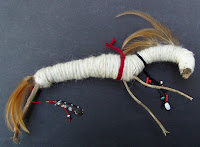So what was “seeded” at the New Moon on the 16th? What intention did I set at that time, consciously or unconsciously? Checking my November journal, I noticed that on the night of the New Moon I had the following dream:
I’m running around happily in “my back yard,” which in the dream is up on a hill. There’s a steep drop-off or even a cliff at the back end, with a creek way below. I hear someone talking loudly—it’s a Vietnamese woman talking to one of her kids, maybe explaining where she’s going or what she wants them to do. I can’t understand her, of course. I run back to watch her, and suddenly find myself standing on the very edge of this cliff, a little below the top. I watch the woman, who is wearing tabis, those Japanese (and Vietnamese?) foot coverings with a separate big toe, as she ducks under a barbed wire fence and wades into the stream. I am a little envious of her apparent freedom.
Then I realize that this cliff is made of soil and very soft sandstone, and that there is nothing beneath me except a 40-foot drop. I’m startled and concerned, so I very carefully clamber back to the top.
 I recognized that last image as a reference to The Fool from the tarot: the fellow who, carrying his knapsack and accompanied by his little dog, strides in blissful ignorance right off a cliff. The Fool, among its many meanings in the tarot, has a kind of “beginner’s mind” feel to it—a trusting innocence that just takes what comes in life without judgement or forethought. It’s one of the Major Arcana, the “trump” cards that indicate something of particular and archetypal importance in a reading.
I recognized that last image as a reference to The Fool from the tarot: the fellow who, carrying his knapsack and accompanied by his little dog, strides in blissful ignorance right off a cliff. The Fool, among its many meanings in the tarot, has a kind of “beginner’s mind” feel to it—a trusting innocence that just takes what comes in life without judgement or forethought. It’s one of the Major Arcana, the “trump” cards that indicate something of particular and archetypal importance in a reading.But who is the Vietnamese woman? What message does she have for me?
In reverie I re-enter the dream: The Vietnamese woman is intent on her business; aware of me but not friendly. She wades upstream; she seems to be gathering things—crayfish, it looks like—from under the rocks. I kick off my shoes, put on my muck boots, and wade in after her. The water is cold and deep and goes right over the top of my boots—I take them off, too, and wade barefoot, which is difficult and painful. The woman glances at me disdainfully, as if to say, “Well. You certainly didn’t prepare yourself, did you?” Her slippered feet have no problem with sharp rocks or algae.
The woman is collecting crayfish. I suddenly remember that crayfish appear in one of the tarot cards: The Moon, another of the Major Arcana. Reading Rachel Pollack’s books on the interpretation of The Moon in the tarot, I notice all kinds of references to wildness, to our sensitivity to life that is so often covered over by ego consciousness. In the context of this card, Pollack suggests, the crayfish may be a symbol of our deepest, most unconscious terrors.
Another connection appears in my mind at that point: at a discussion with a group of depth psychologists the Sunday before the dream, our topic was the movie “Where the Wild Things Are,” which deals in an imaginal way with our deep need to allow our inner wildness to be expressed. The crayfish may symbolize terror of and from the unconscious; but the Vietnamese woman is hunting them for food. The crayfish is food for the body; the terrors of the deep unconscious, perhaps, are food for my soul, and I must search for them without the imagined protection of the rubber boots of ego consciousness.
It is difficult to explain the relationship of all this with my private life at the moment, simply because much of what I am struggling with is so very private. I have lately been feeling a strong tug toward involvement with the world—with my business endeavors, with my book, with friends new and old, with things that feel strange and uncomfortable. I have been resisting that pull, hiding out in the barn with the horses. This dream suggests that isolation is no longer the best idea. Like The Fool, I need to summon my basic innocence and trust in the Universe. I have to get into the water—I can no longer stay dry and safe and uninvolved. But at the same time I need to take precautions, to prepare myself so that I can be effective and not get hurt.
One final, provocative connection, in the words of a song that I heard that same night: “It’s never too late to reach out your hand in love.”
[Note: the image of the moon is by Ghirlandajo, obtained from Wikimedia Commons; the image of The Fool is my photo of the card from the Ryder-Waite tarot deck.]
















